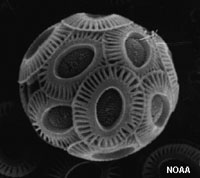13.6: Golden and Green Algae
- Page ID
- 10354
Golden Algae
Golden algae are characterized by the presence of the pigments chlorophyll, carotene, and xanthophyll, which impart yellow-brown to golden colors. the name golden algae encompasses nearly three dozen genera, and over a thousand species in oceans and bodies of water worldwide. The dominant types of golden algae in the marine environment include diatoms, coccoliths, and dinoflagellates.
Diatoms: (from Greek diatomos meaning "cut in two”) Diatoms are the most productive in the oceans. They have skeletal cell walls (tests) composed of silica and thrive mostly cooler waters. Their tests come in a variety of shapes but has a top and bottom that fit together like a shoe box and a single cell in the “box” (Figure 13.7). Nutrients and waste are pushed through the test perforations. Diatoms are the chief component of siliceous ooze throughout ocean basins. Diatomaceous earth (or diatomite) is a naturally occurring, soft, siliceous sedimentary rock that is easily crumbled into a fine white to off-white powder used in filters and manufacture of glass and ceramic products.

Coccoliths (coccus-berry, lithos-stone)(also called coccolithopores): These produce less than the diatoms. They have a calcareous shell that is made up of a number small individual round plates (Figure 13.8). Coccoliths have calcareous tests prefer warmer waters. Coccoliths are the prime component of calcareous ooze which becomes the sedimentary rock: chalk.

Dinoflagellates (dino-whirling flagellum-whip) (Figure 13.9): These have cellulose tests which are biodegradable (typically not preserved in marine sediments).
They also have a small whip-like tail which provides a small means of locomotion.
These are the critters that produce red-tides or harmful algae blooms (HAB).


Green Algae
Green algae (and plants, which share ancestral roots) developed much later, and utilize chloroplasts—internal organelles that use “chlorophyll” (photosynthetic compounds) that produce sugars for metabolism. Chloroplasts are thought to have evolved by through symbiosis between primitive (and ancient) cyanobacteria and other eukaryotic cells. For instance, lichens are a combination of a symbiotic algae and a fungus. Mitochondria in cells are also an example of ancient symbiosis of ancient bacteria. Photosynthesis is the mechanism for organisms to first thrive in the oceans, and eventually on land.


